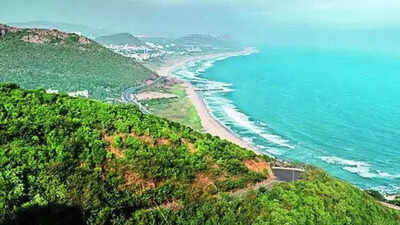Trending
Underwater Krishna-Godavari basin landslide can trigger tsunami: Scientists
A significant landslide in the Krishna-Godavari Basin, discovered by the National Institute of Oceanography, poses risks to underwater structures and potential tsunami threats. Occurring between 2009 and 2015, the landslide displaced 11 cubic km of sediments. Factors such as Cyclone Helen and earthquakes contributed. Offshore industries face risks from these underwater disasters, prompting calls for more research and monitoring.
PANAJI: A recent discovery of a huge landslide in the Krishna-Godavari Basin could pose serious risk to underwater structures and might even lead to a tsunami, Goa-based National Institute of Oceanography (NIO) has said. “The huge landslide can displace a huge amount of water and bottom sediments causing even a tsunami,” NIO director Sunil Kumar Singh told TOI.

The NIO scientists discovered the landslide in the Bay of Bengal only recently and reckon that it could have occurred anywhere between 2009 and 2015. “It poses a huge risk to communication cables and oil rigs that are under water, as well as people living on the coast,” the NIO said.
The scientists believe that when the landslide occurred, it caused a massive section of the seabed to collapse, moving around 11 cubic km of sediments enough to fill about 44 lakh Olympic-size swimming pools.
This giant underwater landslide, known as a mass transport deposit (MTD), has created a large fan-shaped deposit on the ocean floor, scientists said. The area that MTD covers is about 70sqkm — about the size of 10,000 football fields.
The landslide reached depths between 950m and 1.1km below the ocean surface, and in some places, the deposits are up to 60m thick, NIO said.
The landslide was uncovered using special equipment that tracks changes in the ocean floor over time and was one of the largest underwater slope failures ever found in this part of the ocean, the institute said.
Scientists believe several things might have caused this landslide. One important factor could be Cyclone Helen, a Category-1 storm that hit the region in November 2013. The cyclone’s powerful winds and strong waves may have triggered the collapse. Other possible causes include extreme flooding events in 2010 and 2013, and a powerful earthquake with a magnitude of 6 on the Richter Scale that shook the Bay of Bengal in May 2014.
NIO scientists said even events like cyclones, heavy rain and earthquakes that seem small on their own can trigger massive underwater landslides, especially if the ocean floor sediments are already weakened.
The institute has warned that the offshore industries working with oil rigs, gas pipelines, and underwater communication cables could face risks from these kinds of underwater disasters.
Scientists are now urging for more research and monitoring of areas like the KG Basin to better understand and predict underwater hazards.

About the Author
Nida SayedEnd of Article
FOLLOW US ON SOCIAL MEDIA
Visual Stories
Hot Picks
TOP TRENDING
Explore Every Corner
Across The Globe








